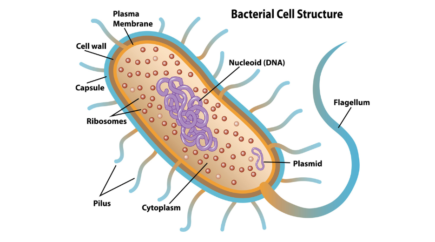Plasmids : Essential Tools For Genetic Engineering
Genetic engineering is the action to modify the genetic information present in a living cell.
Adding, substituting or removing a genetic information in a given biological system necessarily implies to physically introduce a new information into the target cell. DNA is the physical support of genetic information. Therefore, genetic engineering relies on the generation of artificial DNA molecules, containing the information of interest, so it can be transferred to the target cells.
Actually, Life already created several ways to transfer DNA material from one cell to another one, so genetic information could be communicated. One of these creations applies to bacteria and has been named ‘plasmid’.
Bacteria are rather simple organisms. They are unicellular, meaning only composed of one cell. They also have a single chromosome, meaning most of their genes is contained in a single DNA molecule.
Simple right? Oh wait, what do you mean ‘most’ of the genes?
Well, on top of having a bacterial chromosome, bacteria may also contain plasmids. Those are smaller circle of DNA that have the ability to replicate (copy themselves) independently of the chromosome. This ability is due to a set of specific genes grouped in a region called ‘Origin of Replication’ or Ori. A single bacteria may contain several copies, sometimes hundreds, of a given plasmid.
Plasmids also contain additional genes that may help the bacteria to adapt to harsher life conditions. Because of their size, they are easy to pass on to other bacteria of the same species (this is called bacterial conjugation), thus participating to the survival ability of the bacterial strain.

Discovered in 1952[1], plasmids were rapidly turned into molecular tools to first amplify, then transfer DNA material into other biological systems. This was possible thanks to the concomitant discovery of both restriction enzymes and DNA ligases during the Sixties. Restriction enzymes constitute a now wide family of proteins able to cut DNA molecules at specific sites defined by their nucleotide sequences. DNA ligases, on opposite are enzymes that can stitch together two DNA fragments.
So, by the end of the Sixties, scientists knew of the genetic code and had an idea of the multitude of texts (Genomes) that were written everywhere in DNA molecules. They also had Scissors (restriction enzymes) to cut pieces of text, and Glue (DNA Ligases) to paste them together. Then started a period of genetic scrapbooking to empirically engineer the first DNA vectors. Giants’ baby steps on the way towards modern genetic engineering.
Today, hundreds of vector backbones have been described for as many purposes.
Generally speaking, DNA vectors aggregate three kind of genetic features:
- The amplification features that ensure a good DNA replication and retrieval from bacterial cultures. Typically, a vector needs at least one Origin of Replication and a selection marker (e.g. resistance gene),
- The genetic information of interest, meaning the features that are to be transferred to the biological system to modify it. It is classically composed of one or several expression cassettes encoding specific gene(s) also referred as transgenes. Historically, transgenes were inserted into engineered plasmids using restriction enzymes. To facilitate the use of these enzymes in cloning vector or gene expression vector, scientists then developed the concept multicloning site (MCS) to create a versatile insertion point within the vector.
- The integration features: in case the genetic integration is intended to be permanent, one need to make sure the information of interest efficiently integrates the genome of the target cell. Merging DNA vector to Chromosomal DNA can be achieved by facilitating DNA recombination. DNA recombination itself relies on different molecular mechanisms. Integration features are genetic functions that will trigger or promote DNA recombination (e.g. selection marker, viral gene or recombinogenic sequences).
[1] Lederberg J (October 1952). « Cell genetics and hereditary symbiosis ». Physiological Reviews. 32 (4): 403–30. CiteSeerX 10.1.1.458.985. doi:10.1152/physrev.1952.32.4.403. PMID 13003535
Despite tremendous progress in a mere 50 years period, the molecular tools the scientific community can rely on are far from fitting all the experimental needs. Indeed, as knowledge increase and questions complexify, the needs for more sophisticated vectors to be designed and produced is challenging the field daily.
